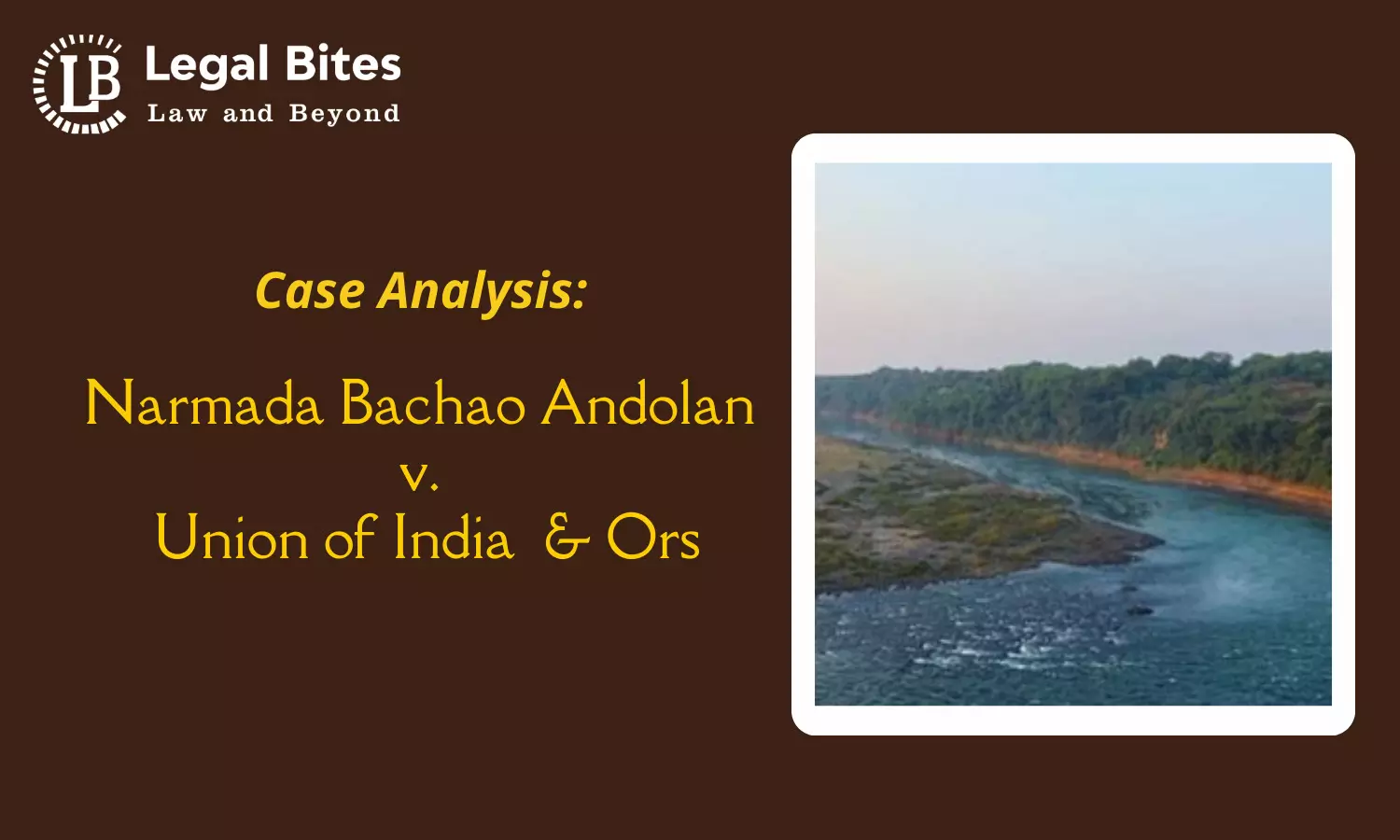Case Analysis: Narmada Bachao Andolan v. Union of India & Ors, (2005)
The 'Case Analysis: Narmada Bachao Andolan v. Union of India and Ors (2005)' highlights the landmark decision of the apex court, balancing development projects with environmental and human rights concerns in a democratic society.

The 'Case Analysis: Narmada Bachao Andolan v. Union of India and Ors (2005)' highlights the landmark decision of the apex court, balancing development projects with environmental and human rights concerns in a democratic society.
Case Title: Narmada Bachao Andolan v. Union Of India And Ors
Citation: Writ Petition (Civil) 328 of 2002
Bench: Y.K. Sabharwal (former CJI), Justice K.G. Balakrishnan and Justice S.B. Sinha
Date of Judgment: 15th March 2005
Court: The Supreme Court of India
Introduction
This case holds paramount significance in the protection of the environment. The Narmada is one of the most important rivers in India. This river supplies its water to the zones in Gujarat, Madhya Pradesh and Rajasthan. The field of water asset debate between nations, influencing the employments and everyday lives of individuals influenced by the development of dams on the Narmada Stream. This river is the fifth biggest and most imperative west-flowing stream in India, streaming through the states of Gujarat, Madhya Pradesh and Rajasthan. At the heart of the strife is the development of major dams on the Narmada River and its effect on both the environment and the nearby communities living within the Narmada River.
Narmada has numerous employments such as creating hydroelectric control, giving new water - a right ensured beneath Article 21 of the Indian Constitution, and providing water to dry regions in Rajasthan and Gujarat employing a framework of canals. A discussion arose over the natural permit allowed by the Prime Minister after a difference between the Service of Water Assets and the Service of Ranger service and Environment.
Facts
The construction of the dam was questioned through writ petitions, in which the petitioners made many arguments to delay the construction. The court, applying the tenet of partition of powers and recognizing the significance of political choices, authorized the development of the dam up to 90 meters tall, with the consent of the natural gather, as well as other information. The Incomparable Court considered the significance of water in Article 21 of the Indian Constitution in this case. The debate centres on the control, utilisation and dissemination of river water. To resolve this issue, the Government of India set up a tribunal. under Section 4 of the Inter-State Dispute Act, of 1956 to resolve the matter.
The court decided effectively considering the height of the dam and guidelines for the state of Gujarat to continue with development.
On April 23, 1994, the Ministry of Irrigation decided to close 10 construction projects. The petitioners asked for an independent judicial review of the entire project. Their main objection was based on “Article 21 of the Indian Constitution and ILO Convention No. 107.” They also supported the implementation of a watershed treatment program and the necessary rehabilitation that would take place well before the lake container was filled.
Petitioner's Argument
The petitioners claimed that the environmental clearance was issued without due consideration as there were no relevant studies at that time in 1987, thus making the progress of the project unacceptable. They argued that further submersion should not be allowed and that the height of the dam should be lowered as the relief and rehabilitation process was hampered. They argued that the project of the dam would destroy the livelihood of many people which would be a violation of their right to life under Article 21 of the Indian Constitution. They proposed that independent entities be responsible for assessing environmental cost prices. and identifying possible mitigation measures. Finally, they stated that the watershed treatment program was incomplete and should have been implemented before the reservoir was filled.
Respondent's Argument
The respondents argued that the decision was an administrative matter and required not to be reviewed by the court. The court is the protector of the fundamental rights of the people. They further stated that government schemes and policies are always for the betterment of society and cannot be challenged. Environmental impacts must be considered comprehensively. They believed that reducing the height of the dam would make electricity production seasonal, leading to power outages. The Narmada Control Authority (NCA) was an independent entity capable of making decisions and issuing judgments, thereby eliminating the need for any other independent body. The Indian government has shown keen concern for environmental aspects, as evidenced by available letters and documents.
Judgment
The court emphasized that for a project as important as this one, completion must be expeditious and compliance with regulations and guidelines must be maintained on a permissible basis. The Supreme Court has issued directives allowing construction of the dam only up to 90 meters, and also stated cannot go above the limit without the permission of respective authorities. The Narmada Control Authority (NCA) was expected to issue further permissions for dam construction.
A vital reason in support of allowing consent may well be the reality that indeed after seven decades of autonomy, not all Indian citizens have satisfactory access to water, which may be a clear infringement of Article 21 and the Resolution of United Nations Human Rights. India's waterways have the potential to reduce the cruel conditions within the country's arid districts, where satisfactory precipitation is uncommon.
When making arrangement choices, the government has the tact to set up approaches and courts ought to not audit such choices unless they struggle with existing law. The use of public interest litigation (PIL) ought to be restricted to certain ranges and not be utilized as a weapon in open intrigued cases.
There has to bridge between diversity in India so that the marginalized are included within the social texture. The government ought to provide fundamental cutting-edge offices such as clean drinking water, satisfactory power, water system administrations and recovery hardware. So, within the nonattendance of any unfavourable circumstances or considering appearing that the dam was hurtful to the environment, the court issued the mandate.
Development of the dam is anticipated to influence an assortment of components, including landmarks, territories, vegetation, fauna and social hones. There's no question that this will thrust tribal communities off the lands they have occupied for eras. Despite these potential impacts, authorization to construct the dam was granted taking into account its positive perspectives. The natural clearance allowed by the Prime Serve has been addressed due to the need for satisfactory inquiry and investigation, which is said to be insulant grounded.
In a majority-rule government, government choices must reflect the view of all segments of society. Policymaking ought to fundamentally be the duty of the government and the legal ought to abstain from mediating unless the arrangement damages sacred arrangements.

